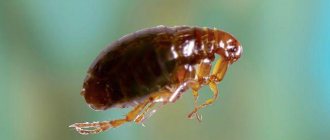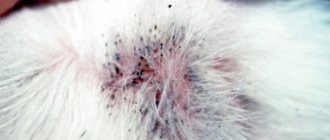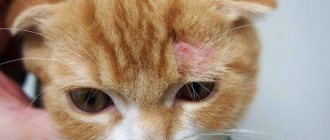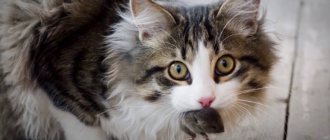A cat is a favorite of the whole family, it brings comfort to our home, gives its owners warmth and joy. For his part, a person must take care of the animal and monitor its health. The main problem that cat owners face is the diseases of their pets, as well as various parasites that often bother them. Fleas are the most common parasite on cats, especially when it comes to animals that walk outside. These require immediate and decisive action on the part of the owner because they seriously undermine their health. These parasites can be carriers of dangerous diseases and pose a danger to humans. They do not live on it, but can feed on its blood through bites.
You can remove fleas from a cat at home, but you should first show the animal to a veterinarian. These pests lead to serious weakening of the animal, in advanced cases it causes anemia, weakens the immune system, which can cause other, more serious diseases. That is why any cat owner should know the first signs of these insects, as well as how to get rid of them.
Insect development cycle
A flea is a small insect without wings that belongs to the blood-sucking order. Typically the size of these parasites is 5–6 mm. Their body, flattened on the sides, has a brown color and a characteristic shine. It is covered with tiny bristles and spines, thanks to which insects are able to move quickly and stay in the fur of their owners.
Fleas are insects with complete metamorphosis. Their life cycle is similar to the developmental stages of a butterfly and consists of the following stages:
- Egg. Flea eggs are so small (from 0.5 to 1 mm) that they can only be noticed upon careful examination. The average duration of egg development under favorable conditions is 2 weeks. Flea eggs can usually be found in carpets and floor crevices, as well as behind baseboards.
- Larva. At the end of the maturation process, larvae emerge from the eggs, which feed on skin particles, blood debris, excrement of adult insects and other decomposing debris. Flea larvae look like translucent, mobile worms with dark spots inside. This spot is the esophagus of an insect with the remains of eaten food. At the end of their growth and molting period, the larvae reach 4–5 mm. This process usually takes 3–4 weeks, after which the larva pupates.
- Doll. After the larva develops into a pupa, it forms a silk-like cocoon around its body. Under favorable conditions, an adult insect will be born within 7–10 days. If environmental conditions are not very suitable for the emergence of an adult, it can wait up to a year for the right moment. This stage of flea development is considered one of the most tenacious. In the pupal stage, the insect easily tolerates cold and exposure to insecticidal preparations in normal concentrations.
- Adult (imago). When favorable environmental conditions occur, adult individuals (imagoes) emerge from the pupa, ready for reproduction. However, in order for mating to be successful, both the female and the male must be well-fed. At the end of the fertilization process, the female immediately begins to lay eggs, but she does not look for a special place for this. Fleas release eggs over fairly long distances as they move, which increases the survival rate of their offspring.
Interesting! A well-fed and healthy flea can lay up to 30 eggs a day, although it usually only has enough strength for 4-10 eggs. During its entire life, the adult lays approximately 500 eggs.
Cat flea: who is it and where does it come from?
To understand where cats get fleas from, you should learn more about these parasites: their structure, feeding habits, and life cycle. Fleas are a huge order of wingless insects that are blood-sucking exoparasites and parasitize on any animal. They have a rather narrow specialization: there are fleas of rabbits (Spilopsyllus cuniculi), dogs (Ctenocephalus canis), humans (Pulex irritans) and cats (Ctenocephalides felis). These insects also parasitize rats and birds. Outwardly, they are very similar; only a professional entomologist can determine the exact type of insect.
general description
What does a flea look like on a cat? Their body size ranges from 1 to 5 mm, the cat flea reaches approximately 2 mm. Males are smaller than females. The parasite that has sucked blood increases sharply in size—approximately 2 times. The insect's body is flattened laterally (this makes it easy to move between hairs) and covered with numerous spines and bristles. They help the insect to stay between the hairs of fur or feathers.
The oral apparatus of the parasite is of the piercing-sucking type, which includes a special stylet that pierces the skin of the host. They do not have a proboscis. The limbs of the parasite are strong, they give it the ability to move along surfaces at any angle, as well as make long jumps. The abdomen has special tactile hairs that are sensitive to air vibrations.
They are wingless insects - with their lifestyle, wings would only get in the way of the parasite. The shape of the body and the chitinous cover make mechanical damage to the insect very difficult - it cannot be crushed with your fingers. The parasite can only be destroyed by crushing it with a fingernail on a hard surface.
This is interesting! Fleas are one of the best jumpers in the animal kingdom. Having a size of only a few millimeters, they can jump 19 cm in height and 30 cm in length. This is a hundred times the size of their own body. A person, in order to repeat these results, must long jump 160 meters.
Life cycle
Fleas are insects with a full life cycle; they have the stages of adult insect, egg, larvae and pupae. The female lays her eggs anywhere, and after about two weeks a worm-like larva appears, which grows and molts several times. The larvae live in dust and debris, feeding on decaying organic matter and excrement.
Later, the larva pupates and after a while emerges from the pupa as an adult insect. Now she just needs to find her owner.
The insect's lifespan is approximately 2 years. Parasites reproduce very actively; during her life, the female lays up to 2 thousand eggs.
Cat fleas can also spread to rats, and they displace the rat flea.
Eating habits
Each type of parasite prefers its own host. They adapt to a certain skin structure, its temperature, the composition of the host’s blood and other characteristics. They can feed on the blood of other animals, but they do not do this very willingly.
Although, it should be noted that in this regard the cat flea is the most picky, as it can easily drink both dog and human blood. She is the champion in the number of bites to people.
Typically, these insects do not live permanently on their host. Rather, it serves as their dining room. They attack him from time to time, drink his blood and leave again. They live near their owner. There are some types of fleas that live permanently on their host; these are parasites of nomadic animals.
They feed daily, but can easily endure several months of fasting, after which they pounce on food with particular greed.
This is interesting! Fleas have changed little over the past 50 million years. The fossil insects that scientists studied are almost no different from modern ones. Evolution, apparently, considered that it had already created a masterpiece, which did not make sense to change.
Diseases
Fleas are carriers of serious diseases in humans and domestic animals. Rat pests are especially dangerous. They carry plague, typhus and other serious diseases. In the Middle Ages, entire cities died out from plague epidemics transmitted by rats.
Fortunately, the cat flea does not carry such dangerous diseases, but other types of these insects can live on your pet.
Where do fleas come from in a domestic cat?
Many cat owners believe that fleas simply cannot come from a clean domestic cat. However, this opinion is just a myth, because these parasites can move independently over quite long distances in search of food. That is why it is advisable for owners of furry pets to have an idea of where fleas can come from in a domestic cat.
There are several ways cats can become infected with fleas:
- Direct contact with an animal already infected with these parasites, including dogs.
- Outdoor shoes, clothes of the owner or his guests, on which they can bring a larva or adult insect.
- The basement or apartment of neighbors who do not treat their pets for parasites.
- Exhibitions, competitions, veterinary clinics and other places where animals gather.
- Rodents also often become a source of infection for cats by these insects.
Interesting! A cat may well become infected with fleas, even if it was carried along the street in a carrier and did not come into contact with other animals.
Ways of flea infection
The lifespan of a flea is 2 years. She easily tolerates cold and heat and can go without food for 1.5 years. These features allow the flea to survive in extreme conditions and wait for the right moment to get on the cat's body. Infection occurs in several ways:
- While walking. Fleas hide in the grass and under stones. When the animal gets close enough, the flea jumps out of its hiding place and clings to the fur.
- Upon contact with a sick animal. A flea can easily jump from one animal to another.
- In contact with rodents. Fleas can live in the fur of rats, and if a cat catches an infested rodent, it can become infected itself.
- From a human carrier. Flea larvae and eggs stick to clothes and shoes, enter the house, mature and attack pets.
In a private house, the main habitat for fleas is the basement or cellar. They easily get into the house, making their way through cracks, open doors and windows. Therefore, the best protection against infection is preventive measures in the autumn-spring period, when fleas are especially aggressive and active.
Why are parasites dangerous?
If you find fleas on your mustachioed pet, you need to start getting rid of the parasites immediately.
Fleas can pose a threat to the life and health of a cat, because they can infect a pet or lead to the development of the following diseases:
- acute intestinal infection;
- helminthiasis;
- infectious anemia;
- hepatitis;
- pseudotuberculosis;
- panleukopenia;
- salmonellosis;
- pasteurellosis;
- tularemia;
- dermatitis;
- allergy;
- mycoplasmosis;
- eczema.
Important! The general condition of domestic felines that have become infected with external parasites is gradually deteriorating. Cats become weak, restless, lose weight and appetite, and go bald.
A flea can infect a person with one of the following diseases:
- plague;
- anthrax;
- hepatitis;
- helminthiasis;
- typhoid fever.
Important! A flea bite can cause a person to develop a severe allergic reaction, swelling, and itching.
What else needs to be done at home
If not only the animal is infected with fleas, but also the apartment in which it lives, the entire home must be treated. Eggs and insects may be present in the cat's bedding or house, on clothes and shoes, and household items. Therefore, along with treating the cat, it is necessary to disinfest the apartment.
Before processing the apartment, a thorough cleaning of the room is necessary. Wash at a temperature of 60 degrees all textiles that can be washed: curtains, bedspreads, blankets, rugs, pillows. It is also advisable to iron all textiles or fry them in the sun. If possible, it is better to treat everything with a steam cleaner. You need to wash all your shoes, wash or dry-clean your outerwear, hats, and scarves.
Then they are treated with an insecticide. It can be in the form of a spray or solution for spraying and wiping surfaces. It is sprayed throughout the room, especially attention should be paid to baseboards, floors, and furniture standing on the floor. It is also advisable to treat upholstered furniture. To treat premises against fleas, you can use insectoacaricides from Medilis: Malathion, Permifen, Super, Cyper, Neo. They destroy not only fleas, but also other parasites unwanted by humans. However, it is necessary to strictly follow the instructions when preparing working solutions and using them.
After the exposure time specified in the instructions has passed, furniture, carpets, floors and other surfaces are vacuumed to remove dead insects. After this, you can wash the floors and other surfaces with water with the addition of strong-smelling essential oils, such as pine or wormwood.
All processing is carried out observing safety precautions. There should be no animals or people in the room. After applying the product, you need to leave the apartment for several hours, and then thoroughly ventilate the entire apartment.
How to determine if an animal has fleas
Owners can find out whether a domestic cat has fleas by visiting a veterinarian. However, it is also not difficult to detect parasites at home – you just need to carefully observe your pet’s behavior.
The main signs of a cat having fleas may be as follows:
- restless behavior;
- hair loss;
- weakness;
- weight loss;
- lack of appetite;
- a sharp reaction to itching;
- the appearance of scratches and non-healing wounds on the skin.
Important! To detect fleas, you can conduct a small diagnostic test on your pet yourself. The owner needs to place the cat on a white sheet of paper, and then comb it or dry it with a white paper towel. If you find black or brown dots on the paper, you can say with 100% certainty that your domestic cat has fleas.
Traditional methods of fighting fleas
Fleas have been pestering pets for a very long time. During this time, many methods of combating them have emerged. Most are safe for pets, but many are not very effective.
There are also more toxic options. For example, remembering that people used to get rid of lice with kerosene, someone is trying to use it against fleas. This should not be done under any circumstances. This leads to serious poisoning and death of the animal.
Most often, cats are bathed in a decoction of wormwood and rosemary, and soap with wormwood is used for washing. If there are a large number of fleas, these remedies do not help. After using all types of soap, it is important to thoroughly rinse the fur so that your pet does not ingest harmful substances.
Other folk remedies for fleas in cats:
- Bathing in salt water (100 grams of salt per liter). The cat should be placed in a bowl of salt water so that the entire head is on the surface. You need to keep the animal in a salt bath for 10 - 15 minutes, then rinse the fur thoroughly using regular baby soap, dry it and comb it thoroughly to remove dead fleas. The procedure is repeated after 5 – 7 days. Several treatments may be needed. Salt baths can be used to remove parasites from kittens and pregnant cats.
- Treatment with tar soap. You can take liquid soap or lather a solid bar. You should get a thick foam, which is applied to the cat’s entire body and left for 15 minutes, after which the cat can be wrapped in a thick towel. To prevent parasites from scattering around the apartment after removing the towel, it is better to keep the cat in the bath. After the required exposure time, the cat is thoroughly washed, dried and combed. The procedure is repeated a week later.
- Essential oils. They don't kill parasites, but they repel them. Oils with strong odors also do not destroy the eggs that fleas have laid in the fur. The oil is used only in diluted form: 3 – 4 drops are diluted in a glass of water. This water is applied to the cat's fur, trying to saturate the entire coat of the animal down to the skin. You can use oils of pine, cedar, eucalyptus, wormwood, lavender, and anise. You can use essential oils with caution to remove fleas from kittens and pregnant cats, but you need to make sure that the animal does not have individual intolerances or allergies. At the same time as treating with oils, you need to carefully comb out the cat's fur. This way you can reduce the number of fleas by simply removing them mechanically, as well as remove eggs and larvae.
- Wormwood decoction. This plant has a very pungent odor that parasites do not like. Prepare the tincture by pouring five tablespoons of dry leaves into a liter of water and bringing to a boil, simmering over low heat for 20 minutes. The broth is cooled, filtered and the wool is generously moistened with it, then the animal is wrapped in a terry towel for 15 - 20 minutes. Then the wool is washed, dried and combed. This product also does not destroy larvae and eggs; they need to be combed out. A decoction of geranium leaves also works. Both remedies must be used several times.
- Homemade flea shampoo. Take liquid tar soap or diluted in water, add egg yolk, finely chopped onion and wormwood decoction to it. You should get a paste that is applied to the moistened coat, rubbing it into the skin. Then the cat is wrapped in a towel for 20 minutes. After exposure, the wool covering is thoroughly washed and dried, then also thoroughly combed.
How to remove fleas from cats
Currently, there are a huge number of effective and safe chemical preparations for external parasites for cats on the market. The most popular among them:
- shampoos;
- sprays;
- drops on the withers;
- pills;
- collars.
Shampoo
Shampoos are one of the most common, but labor-intensive methods of ridding a cat of fleas. They usually contain several active ingredients at once, so they can destroy external parasites of various types.
Shampoos are recommended for use for minor infestations or in combination with other flea products. Before using shampoo, owners should make sure that it is intended specifically for cats, since products for dogs can lead to the death of a purring pet. After rinsing off the product, you need to rinse the cat's fur very thoroughly under warm running water so that the cat does not get poisoned when licking it.
Many shampoos can be used even if the kitten is only 1 month old - they are made based on plant extracts and are therefore safe.
Spray
Sprays are considered the fastest way to kill external parasites in a cat. With their help you can get rid of fleas within a few hours.
Sprays are recommended for use on short-haired animals: they cannot penetrate deep into very long hair, so after applying it the insects will not die.
Treating your pet with a spray should be done outside or in a well-ventilated area. During the procedure, the cat must be wearing a protective collar to prevent licking of the drug and to prevent it from getting into the eyes and nose.
Important! Using an anti-flea spray, it is also recommended to treat all places in the house that your pet comes into contact with.
Drops on the withers
Drops on the withers are a very convenient way to combat fleas and other external parasites for adult cats and kittens. It is suitable for treating long-haired and short-haired pets and provides them with protection from infection for a month.
Anti-flea drops cannot be used to treat kittens younger than 2 months, pregnant, lactating, sick or weakened cats.
Pills
Tablets are very effective against fleas, but most of them only affect adult fleas. Recently, drugs based on the hormone luferonone have begun to appear on the market. This substance helps the eggs dry out and prevents the larvae from turning into pupae. Such tablets are harmless to people and cats, including pregnant, lactating and kittens.
The principle of action of the tablets is very simple: the drug dissolves, penetrates the cat’s blood, and the insect dies after the bite.
Tablets are allowed to be taken together with anthelmintic drugs, but it is still better to first rid your pet of external parasites, and then of internal parasites. This is the only way to prevent re-infection.
Collar
Collars are the easiest way to protect your cat from fleas. Thanks to treatment with a special substance, they repel insects, but cannot destroy them on their own. Collars are recommended to be used in combination with shampoo, spray or drops.
Before using this product, owners need to carefully study the composition of the substances contained in it, since some of them cause allergies and irritation in cats. In addition, owners need to change it to a new one approximately once every 1-2 months, because the validity period of such a product is limited. Otherwise, the cat will be susceptible to external parasites.
Expert opinion
Chepa Natalya Semenovna
Veterinarian
Ask a Question
Among cats, fold-eared breeds are most prone to otitis, because... they have a small closed ear and a narrow ear canal that is poorly ventilated. Hairless breeds produce a lot of sulfur, which can also be a predisposing factor for the development of otitis media. A common mistake owners make when caring for their ears is using a cotton swab. It will not be possible to clean the ear well with a cotton swab due to its structure, but leaving the cotton swab, “compacting” the wax inside the passage and causing irritation of the skin of the ear canal is quite likely. For home care, it is best to use special lotions no more than once a month. You should not use multi-component ear drops on your own. Medications should be prescribed by a doctor based on a cytological examination.
Using flea collars
A very popular remedy among cat owners. The collar is impregnated with special preparations that repel fleas. It is effective, but its range of action is very limited, that is, it protects the front of the cat, while the back remains unprotected. It is important that the collar is intended specifically for cats, otherwise the dosage may be too high and the drug may be toxic. Collars need to be changed promptly, as they are valid for no more than a month. You also need to consider that collars can irritate the skin and cause allergies.
A type of collar is a flea keychain for a cat. It is hung on a collar or placed in a house or on a bed where the cat is used to lying. The key fob is battery operated. It emits ultrasound, which is not dangerous to the cat, but repels fleas within a meter radius.
Preventing fleas in cats
Owners' compliance with the following recommendations will help them protect their cat from fleas:
- Do not allow your pet to come into contact with infected animals.
- Regularly carry out not only wet cleaning in the apartment, but also use a vacuum cleaner.
- Treat your cat every 3-6 months with medications for external parasites.
- Do not let your pet walk on its own.
- Bring your pet to a veterinary clinic every year to detect the presence of parasites in time.
- Wash clothes only in hot water and put them in the closet only after they are completely dry.
- Brush your furry pet's fur regularly.
A responsible and caring owner must know where fleas come from on a domestic cat and follow all measures to prevent infection. After all, these insects are very dangerous and unpleasant parasites that harm the health of not only the pet, but also its owner.











